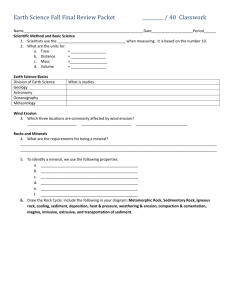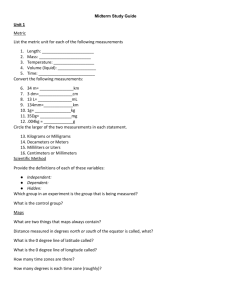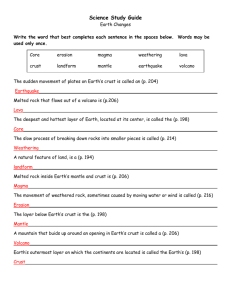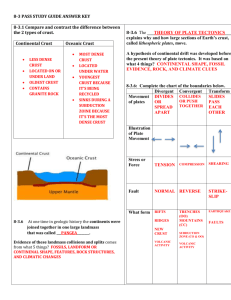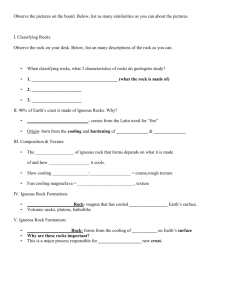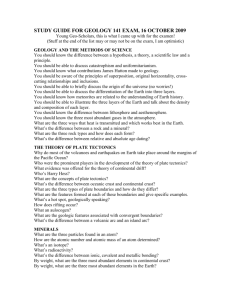Geology-Exam-Study
advertisement
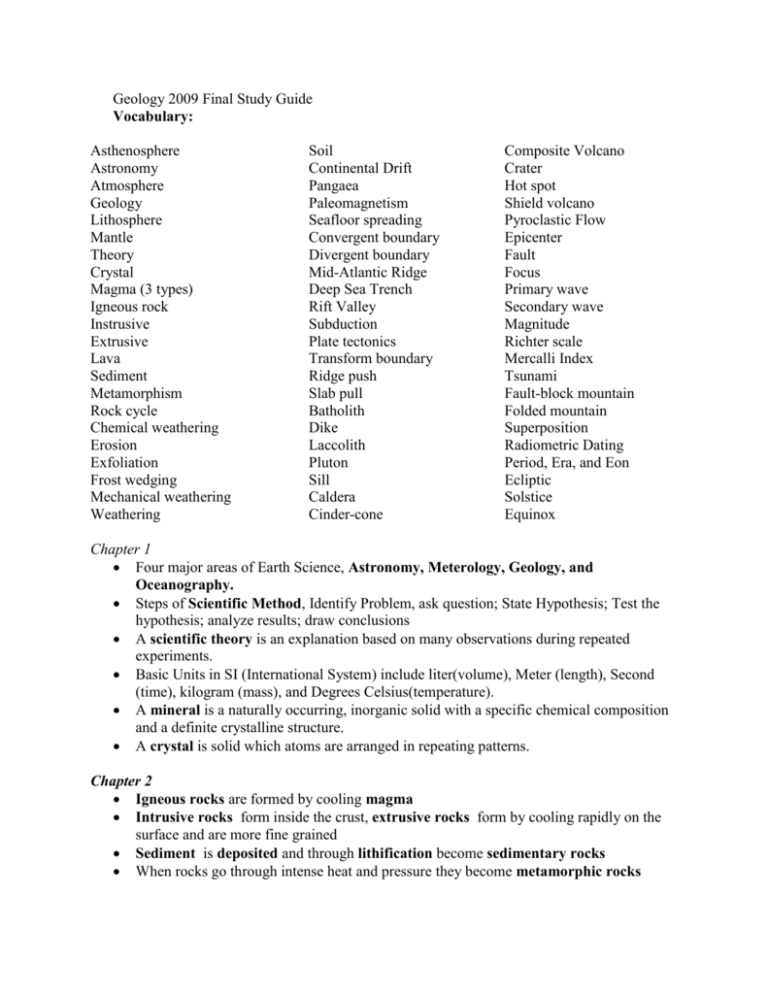
Geology 2009 Final Study Guide Vocabulary: Asthenosphere Astronomy Atmosphere Geology Lithosphere Mantle Theory Crystal Magma (3 types) Igneous rock Instrusive Extrusive Lava Sediment Metamorphism Rock cycle Chemical weathering Erosion Exfoliation Frost wedging Mechanical weathering Weathering Soil Continental Drift Pangaea Paleomagnetism Seafloor spreading Convergent boundary Divergent boundary Mid-Atlantic Ridge Deep Sea Trench Rift Valley Subduction Plate tectonics Transform boundary Ridge push Slab pull Batholith Dike Laccolith Pluton Sill Caldera Cinder-cone Composite Volcano Crater Hot spot Shield volcano Pyroclastic Flow Epicenter Fault Focus Primary wave Secondary wave Magnitude Richter scale Mercalli Index Tsunami Fault-block mountain Folded mountain Superposition Radiometric Dating Period, Era, and Eon Ecliptic Solstice Equinox Chapter 1 Four major areas of Earth Science, Astronomy, Meterology, Geology, and Oceanography. Steps of Scientific Method, Identify Problem, ask question; State Hypothesis; Test the hypothesis; analyze results; draw conclusions A scientific theory is an explanation based on many observations during repeated experiments. Basic Units in SI (International System) include liter(volume), Meter (length), Second (time), kilogram (mass), and Degrees Celsius(temperature). A mineral is a naturally occurring, inorganic solid with a specific chemical composition and a definite crystalline structure. A crystal is solid which atoms are arranged in repeating patterns. Chapter 2 Igneous rocks are formed by cooling magma Intrusive rocks form inside the crust, extrusive rocks form by cooling rapidly on the surface and are more fine grained Sediment is deposited and through lithification become sedimentary rocks When rocks go through intense heat and pressure they become metamorphic rocks Chapter 3 Rocks can be broken down by chemical and mechanical weathering Erosion is the process which moves weathered material Moving water, glaciers, wind and gravity cause erosion. Gravity is the driving force of all erosion Soil is made of weathered rock and decaying organic matter Chapter 7 Matching coastlines of continents suggest continents were joined in a single land mass called Pangea Wegener supported continental drift hypothesis with rock, fossils, and ancient climatic data. He could NOT explain HOW they moved During Sea Floor Spreading, magma rises and cools to form new crust. This crust is then separated and new magma rises forcing the older crust away from the ridge Convection is energy moving from the hot interior and rising to the cooler exterior which drives plate tectonics. Plate Tectonics states that Earth’s crust and rigid upper mantle are broken into plates and move over Earth’s surface The three major types of boundaries are divergent, convergent, and transform. You will need to be familiar with how they move, which crusts are involved and what features are associated with each! Understand Ridge push and slab pull Chapter 8 Understand the three types of volcano: cinder cone volcano, composite volcano, and shield volcano Understand the magma involved: Basaltic, Andesitic, and Rhyolitic Know the differences where the volcanos form, their lavas’ viscosity, silica content, gas content, and explosiveness. Igneous intrusions are called Plutons. These include Dikes, sills, batholiths, laccoliths and stocks. Be able to identify them in a diagram Know what causes a Hot Spot volcano Chapter 6 Understand how Stress, strain, and faults are related Understand p-waves and s-waves and the interactions of these waves with the interior of Earth. An Earthquake’s damage and intensity is measured by the Modified Mercalli Scale A wave generated by an earthquake in the ocean is called a tsunami. The probability of an earthquake is based on history and the places on a fault that have not experienced a quake for a while is called a seismic gap. Chapter 9 All mountains are formed by a process called orogeny. Crust getting uplifted can cause Uplifted Mountains If large pieces of crust are tilted or dropped between normal faults it forms Fault block mountains Rocks made at ocean ridges include pillow basalts. Chapter 10 Absolute age of rocks is found by radiometric dating The time it takes for 1/2 of the original material in an isotope to decay is called a half life Index Fossils are widely distributed and easily recognized. They lived a short period of time and are useful for geolgists. The oldest rock layer in a sequence is on the bottom A gap in a rock sequence is called an unconformity Periods are defined by life forms in either abundance or extinction at the time. Chapter 19 Our sun’s position changes through the year and our seasons are caused by the Earth’s tilt. The solstices are the highest and lowest positions of the sun in the sky Understand what causes solar and lunar eclipses The moon is in synchronous rotation with the earth The earth moves around the sun in the shape of an ellipse
